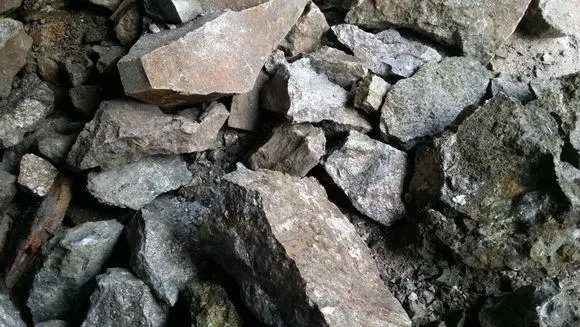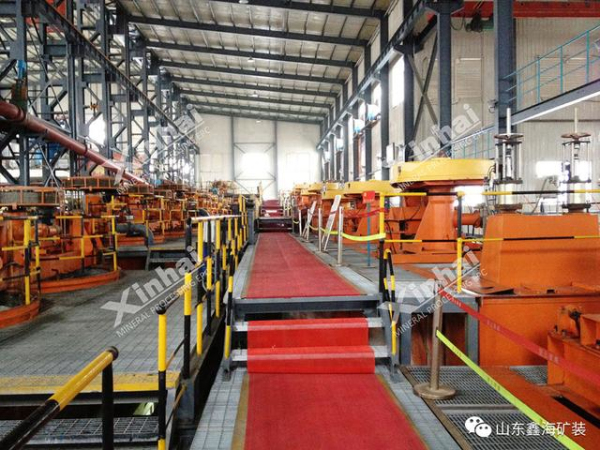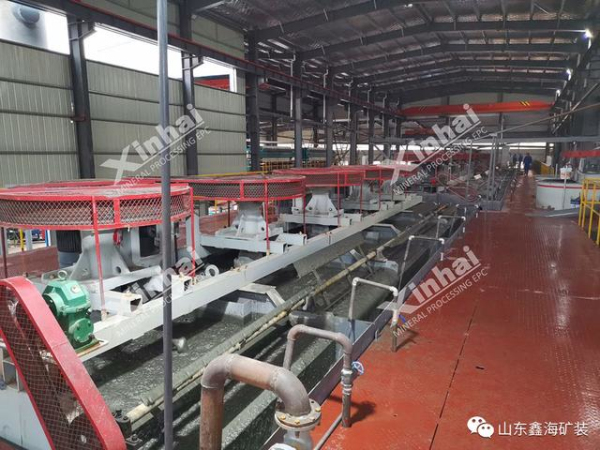The beneficiation of copper-bearing gold ores is difficult because copper have a great impact on gold leaching. Copper interacts with the cyanide solution to form a copper-cyanide complex, resulting in a large consumption of cyanide.

With the exception of malachite and chalcopyrite, which have weaker reaction with cyanide, almost all copper minerals dissolve fairly quickly and completely in cyanide solution. Copper-cyanide complex forms a thin film on the surface of gold, slowing the dissolution rate of gold, thereby affecting the gold leaching rate.
The ore is mainly oxidized ores, with little metal mineral content, but many kinds of minerals. The main metallic minerals are pyrite, covellite, limonite and a small amount of bornite, chalcopyrite, chalcocite, galena, sphalerite and so on. Gangue minerals are mainly quartz, sericite, dolomite and calcite.
Gold is dominated by free gold, followed by sulfide-encapsulated gold, and the gold particles are small. Copper is dominated by copper oxide, and the oxidation rate of copper is 83.78%, of which free copper oxide accounts for 56.23%.
For the copper-bearing gold ore, we carried out direct full-slime cyanidation, ammonia leaching-cyanidation, acid leaching-cyanidation, and flotation experiments.
The results show that the use of "Treat sulfide ore first and then oxide ore " preferential flotation-flotation tailings cyanidation process has achieved good technical indicators, the gold recovery rate can reach 93.41%, and the silver recovery rate can reach 68.81%.
At the same time, using cyanidation to process the two kinds of concentrates obtained by flotation, we obtained good leaching indexes.

1. Exploration Test of Cyanidation of Sulfide Concentrate
In order to study the possibility of using cyanidation to process sulfide gold concentrate obtained by flotation, cyanide leaching experiment was carried out.
The test results show that the leaching rate of gold reaches 95.92% under the conditions of grinding fineness-320 mesh, 80% of sodium cyanide, 0.12% of sodium cyanide, and 24h of cyanidation, which is an ideal test index.
However, what should be paid attention to is that some copper is still leached out. When the cyanide lean solution is recycled for many times, the copper ions will continue to accumulate, which will affect the leaching of gold.
2. Acid Leaching-Cyanidation Test of Copper Oxide Concentrate
The copper oxide concentrate obtained in the closed-circuit flotation test contains 4.75% copper and 19.40 g/t gold. Due to the high content of copper oxide, the leaching of gold is seriously affected, which not only increases the consumption of sodium cyanide, but also reduces the leaching rate of gold. We have to remove copper before using cyanidation process.
We carried out an acid leaching-cyanidation test. After leaching in dilute sulfuric acid with a volume concentration of 5% for 4 hours, we adjusted the pH value to 11 with lime, and keep the mass fraction of NaCN at 0.12%, then perform the leaching for 24 hours.
The test results show that using cyanidation to process copper oxide concentrate after acid leaching, the sodium cyanide content is reduced, the consumption is 500g/t, and the gold leaching rate is 93.56%, which are good test indicators.

a. The gold in this ore is produced in the form of natural gold, mainly free fine-grained gold, followed by sulfide-encapsulated gold. The harmful impurity element copper affecting leaching mainly exists in the form of copper oxide, especially free copper oxide is up to 56.23%, which is extremely unfavorable for cyanide leaching of gold.
b. Using cyanidation right after fine grinding of the raw ore would reach a poor result, mainly due to the high copper content in the ore, especially the presence of free copper oxide and secondary copper, which not only consumes a large amount of sodium cyanide, but also seriously affects the leaching rate of gold. The finer the particle size, the lower the gold leaching rate and the higher the consumption of sodium cyanide.
We used closed-circuit flotation - flotation tailings cyanidation test for this kind of ore, and the total recovery rates of gold and silver reached 93.41% and 68.81%, respectively.
c. Carrying out cyanidation exploration tests for the two products obtained by flotation, namely sulfide concentrate and copper oxide concentrate, can obtain good leaching indexes.
The sulfide concentrate was finely ground and leached by cyanidation after reagent removal, and the leaching rate of gold reached 95.92%. After acid leaching of copper oxide concentrate, we treat the tailing with cyanidation, and the leaching rate of gold would reach 93.56%.
However, what needs to be paid attention is that some copper is still leached out. When the cyanide lean solution is recycled for many times, the copper ions will continue to accumulate, which will affect the leaching of gold. At the same time, the discharge of the solution with high copper ions will pollute the environment. So we must add an operation of copper removal operation, which will increase the cost.
Therefore, in actual production, it is necessary to choose carefully between the direct sale of flotation products and using cyanidation to process.